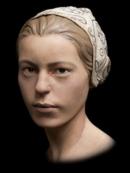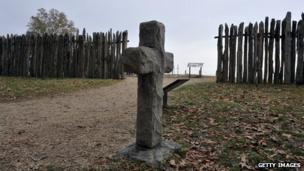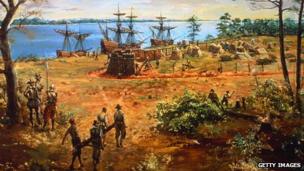'Proof' Jamestown settlers turned to cannibalism
Newly discovered human bones prove the first permanent British settlers in North America turned to cannibalism over the cruel winter of 1609-10, US researchers have said.
Scientists found unusual cuts consistent with butchering for meat on human bones dumped in a rubbish pit.
The four-century-old skull and tibia of a teenage girl in James Fort, Virginia, were excavated from the dump last year.
James Fort, founded in 1607, was the earliest part of the Jamestown colony.
'Starving Time'
"The evidence is absolutely consistent with dismemberment and de-fleshing of this body," said Doug Owsley, a forensic anthropologist at the Smithsonian National Museum of Natural History in Washington DC.
Written documents had previously suggested the desperate colonists resorted to cannibalism - but the discovery of the 14-year-old girl's bones offers the first scientific proof.
Smithsonian researchers believe the dead child became food for a community struggling to survive the harsh winter of 1609-10, known to historians as the Starving Time.
"There were numerous chops and cuts - chops to the forehead, chops to the back of the skull and also a puncture to the left side of the head that was used to essentially pry off that side," Dr Owsley said. "The purpose was to extract the brain."
The marks also indicate that the tongue and facial tissue were removed.
"The clear intent was to remove the facial tissue and the brain for consumption," he said. "These people were in dire circumstances. So any flesh that was available would have been used."
The same flesh taken from animals would have been considered a delicacy in the 17th Century. Hogs' heads in particular featured prominently in recipes from the period.
The cuts to the girl's bones also indicate the work was hesitant - whoever performed the dismemberment was not a skilled butcher of animals.
It is also possible the ersatz butcher was a woman, as they made up the majority of the fort's inhabitants.
How the girl died is unknown, but the assault on her body would have taken place very soon afterwards.
"The attempt to [remove] the brain is something you would need to do very quickly because brains do not preserve well," Dr Owsley said.
Dr Owsley worked closely with chief archaeologist William Kelso of the Jamestown Rediscovery Project. Dr Kelso discovered the girl's bones last year during excavations at James Fort.
Under siege
Little is known about the victim apart from her age and the fact she was English. Her origin has been confirmed by comparative studies on bones in Cambridge.
Further analysis indicates she was at one time well-nourished and ate a lot of meat, a diet consistent with richer classes.
Researchers also have a sense of what she looked like thanks to digital and forensic facial reconstruction. The fragmented skull was scanned, with the digital information providing a virtual model from which to fashion a three-dimensional replica.
The Starving Time was one of the most horrific periods of early colonial history. The James Fort settlers were under siege from the indigenous Indian population and had insufficient food to last the winter.
First they ate their horses, then dogs, cats, rats, mice and snakes. Some, to satisfy their cruel hunger, ate the leather of their shoes.
As the weeks turned to months, nothing was spared to maintain life. How many of the growing numbers of dead were cannibalised is unknown. But it is almost certain the girl was not the only victim.
Relief came in the form of Lord De La Warr, who sailed into the settlement with food and new colonists. After six months of siege and starvation, only 60 of the original 300 settlers had survived.
"It's somebody doing what they had to do," said Dr Owsley of the cannibalism.



No comments:
Post a Comment